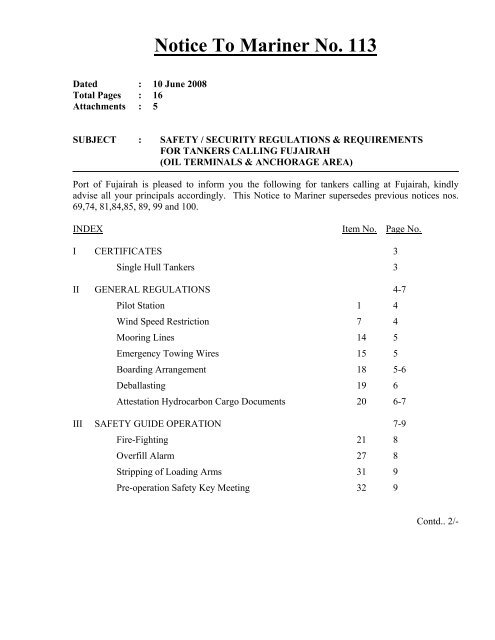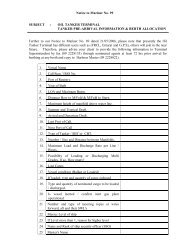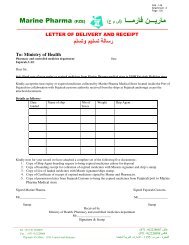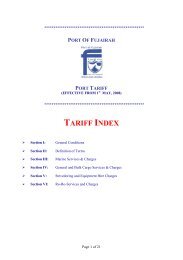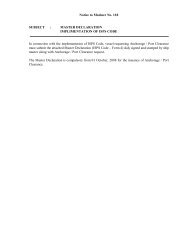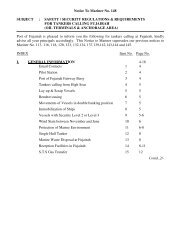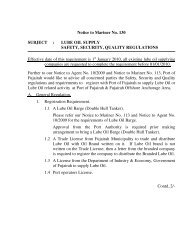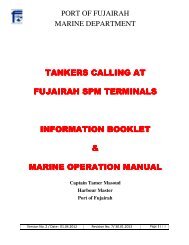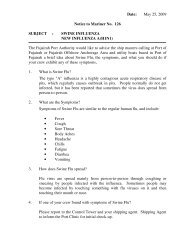Notice To Mariner No. 113 - Port Of Fujairah
Notice To Mariner No. 113 - Port Of Fujairah
Notice To Mariner No. 113 - Port Of Fujairah
Create successful ePaper yourself
Turn your PDF publications into a flip-book with our unique Google optimized e-Paper software.
<strong><strong>No</strong>tice</strong> <strong>To</strong> <strong>Mariner</strong> <strong>No</strong>. <strong>113</strong>Dated : 10 June 2008<strong>To</strong>tal Pages : 16Attachments : 5SUBJECT : SAFETY / SECURITY REGULATIONS & REQUIREMENTSFOR TANKERS CALLING FUJAIRAH(OIL TERMINALS & ANCHORAGE AREA)<strong>Port</strong> of <strong>Fujairah</strong> is pleased to inform you the following for tankers calling at <strong>Fujairah</strong>, kindlyadvise all your principals accordingly. This <strong><strong>No</strong>tice</strong> to <strong>Mariner</strong> supersedes previous notices nos.69,74, 81,84,85, 89, 99 and 100.INDEXItem <strong>No</strong>. Page <strong>No</strong>.I CERTIFICATES 3Single Hull Tankers 3II GENERAL REGULATIONS 4-7Pilot Station 1 4Wind Speed Restriction 7 4Mooring Lines 14 5Emergency <strong>To</strong>wing Wires 15 5Boarding Arrangement 18 5-6Deballasting 19 6Attestation Hydrocarbon Cargo Documents 20 6-7III SAFETY GUIDE OPERATION 7-9Fire-Fighting 21 8Overfill Alarm 27 8Stripping of Loading Arms 31 9Pre-operation Safety Key Meeting 32 9Contd.. 2/-
2IV PORT OF FUJAIRAH OIL TERMINALS 9-11OIL TERMINAL 1 1 9General Information 1.1 9Berth Construction & Design Criteria 1.2 10<strong>No</strong>tification of Ship’s Arrival Information &Confirmation 1.3 10-11V VOPAK HORIZON FUJAIRAH LIMITED TERMINAL 12-13Berth Construction & Design Criteria 12Berth <strong>No</strong>. 1 & 2 1 12Berth <strong>No</strong>. 3 & 4 2 12Single Point Mooring (SPM) 3 13VI UNBERHTING NOTICE 13VII S.T.S OPERATION 14Prohibited S.T.S Operation at off <strong>Port</strong> Limit 1 14Ship to Ship Regulation 2 14Certificates, General Regulations and SafetyGuide Operation 3 14Information Required 4 14VIII SECURITY 15Entry Regulation A 15Instruction for Vessel’s crew at Oil Terminal -1 B 15IX MARINE & PORT HANDLING CHARGES 16Attachments :1. Checklist - Ship Certificates2. CAS Checklist3. Emergency <strong>To</strong>wing Wires4. Permission to Enter – ISPS Form <strong>No</strong>.15. Tanker Pre-Arrival information.Contd..3/-
3I. CERTIFICATESTankers calling at <strong>Port</strong> of <strong>Fujairah</strong> Oil Terminals or F.O.A.A must have the following validoriginal statutory certificates & documents onboard,a) Load Line Certificateb) Cargo Ship Safety Construction Certificatec) Cargo Ship Safety Equipment Certificated) Cargo Ship Safety Radio Certificatee) Civil Liability Certificate issued from flag state (issued in accordance with provisionsof International Convention on Civil Liability for Oil Pollution Damage 1992)f) The International Oil Pollution Prevention (I.O.P.P) Certificateg) Certificate of Ship’s Registryh) Certificate of Class (Hull & Machinery)i) Ship Sanitation Control Exemption Certificatej) ISM Safety Management Certificatek) Oil Record Books (Engine / Cargo & Ballast Operations)l) Shipboard Oil Pollution Emergency Plan (SOPEP)m) International Air Pollution Prevention Certificate (IAPP) (if applicable)n) International Ship Security Certificate (ISSC)o) Shipboard Marine Pollution Emergency Plan (SMPEP) (Chemical vessels only)p) NLS Certificate (Chemical vessels only)q) Certificate of Fitness (Chemical vessels only)<strong>No</strong>te :Tanker requesting Anchorage / <strong>Port</strong> Clearance must submit copies of abovecertificates in advance along with duly filled "CHECKLIST - SHIPCERTIFICATES" (Attachment 1).For Single Hull Tankers1. Single Hull Tankers of more than 25 years of age are not allowed for any Hydrocarbonoperations regardless ship's Dead Weight.2. CAS Certificate and Flag State Permission required for Single Hull Tankers between 15& 25 years of age along with duly filled "CAS CHECKLIST" (Attachment 2).Contd..4/-
4II.GENERAL REGULATIONS1. Pilot Stationa) <strong>Port</strong> of <strong>Fujairah</strong>i) <strong>Port</strong> of <strong>Fujairah</strong> Fairway BuoyCo-ordinates: 25 0 09.33’ N & 056 0 22.2’ ELight : FL.R.2sii) Pilot Station for vessels calling <strong>Port</strong> of <strong>Fujairah</strong>Half nautical mile East of <strong>Port</strong> of <strong>Fujairah</strong> Fairway Buoy, that means atPosition,25 0 09.33’ N & 056 0 22.73’ Eb) Vopak Horizon <strong>Fujairah</strong> LimitedPilot Station for tankers calling at Vopak Horizon <strong>Fujairah</strong> Terminal is atposition,075 0 x 2.0 Nautical Mile from <strong>Fujairah</strong> Breakwater Racon, co-ordinates,25 0 11.00’ N & 056 0 24.27’ E2. Berthing / Unberthing available round the clock.3. Vessels will be berthed on first come first served basis.4. Maximum allowed trim berthing / unberthing and alongside is 0.015 x LOA.5. All communication whilst Cargo Operation at Oil Terminals by U.H.F and theChannels as decide by Terminal Superintendent.6. In case of Pollution or Fire, immediately inform the <strong>Port</strong> Control.7. Wind Speed restriction for Marine Loading Arms.‣ Service position : 30 knots‣ Operational Position : 40 knots‣ Parked position : 80 knots8. Immobilising, Maintenance, Hot work, Tank cleaning and tank washing are not allowedat Oil Terminals.9. Crew change is allowed at <strong>Port</strong> of <strong>Fujairah</strong> Oil Terminals, but is not allowed at VopakTerminal.10. Fresh water supply available through pipeline at <strong>Port</strong> of <strong>Fujairah</strong> Oil Terminals.11. De-slopping by shore pipeline not available at the Terminals.12. Bunker/Slop barges/Utility Boats are not allowed whilst alongside Oil Terminals.13. If there are any protrusions on ship’s hull, then ship’s agent should arrange pneumaticfenders.Contd..5/-
514. Mooring lines14.1 Ropes or wires acceptable.14.2 Wires should be used for mooring if available.14.3 If vessel uses ropes and wires at the same time, mixed mooring not allowed forleading in the same direction of head, stern, breast and or springs.14.4 All mooring lines should be in good condition and tended to with same tension.15. Emergency <strong>To</strong>wing WiresTwo Emergency <strong>To</strong>wing wires, length 50-55m, diameter according to deadweightstipulated in OCIMF Mooring guidelines, to be provided one forward and one aft on theweather deck. The wires must be the type recommended for good quality mooringwires each wire must have two eyes. One eye goes over the ship’s bollard with extrafour turns to take the tension for a safe and secured towing. The other eye must bemaintained one metre above the waterline at any freeboard. Please find attached sketch(Attachment 3).16. All personnel on deck shall be wearing appropriate personal protective equipment.17. Transfer of Gas by S.T.S operation is not allowed at <strong>Fujairah</strong> <strong>Of</strong>fshore AnchorageArea.18. Boarding Arrangementsa) Safe Embarkation and Disembarkation of the PilotThe master of a ship navigating in the port or approaches, shall afford suchsuitable “Weather lee” and speed reductions as dictated by the practices of goodseamanship in order to provide a safe embarkation or disembarkation operation.Pilot ladder and associated equipment to comply with SOLAS standards and therequirements of International Pilot's Associationb) Pilot LadderA clean and efficient pilot ladder fitted with spreaders and manropes shall bemade available for the pilot to embark or disembark. At night the ladder need tobe illuminated with efficient and safe light.c) Supervision of Pilot LaddersThe rigging of pilot ladders for the embarkation/disembarkation of pilots shall besupervised by a responsible ship’s officer, and shall be so effected that the ladderis well clear of any overboard discharge and that each step of the ladder restsfirmly against the side of the ship. Pilot boarding / disembarking shall also besupervised by a responsible ship’s officer.d) Accommodation and Pilot Ladder (combination)Whenever, as in the case of large vessels, the height of the deck above thewater level exceeds 30 ft (9.0 metres) the accommodation ladder shall also beused in conjunction with the pilot ladder and shall be lowered to above 22 ft (7.0metres) above the water level with the pilot ladder immediately adjacent to thebottom of the accommodation ladder.Contd..6/-
6e) Mechanical HoistsA mechanical hoist of an approved pattern shall be considered an acceptablealternative to a conventional pilot ladder to be used in conjunction with theaccommodation ladder.NOTE:Mechanical hoists whose operation relies upon a single wire are not of approvedpattern under these rules.19 DeballastingIf vessel is Segregated Ballast Tanker (SBT) of the Double Hull type and all ballastwater contained in the ballast tanks is totally segregated from the cargo tanks, thisincludes the vents and pipelines, testing inspection before deballasting shall not beapplicable.If deballasting is required for CBT (Clean Ballast Tankers) while loading operation,permission can be obtained with the following terms and conditions,a. Deballasting must be in daylight under inspection, testing and monitoring of anapproved petroleum inspector from Testing Services or Oil Laboratory.b. The Chemist Surveyor must board the vessel on arrival at anchorage priorberthing for sampling and testing the ballast tanks and double bottom tankscontaining clean ballast water. The analysis & results must be informed to the<strong>Port</strong> Control <strong>To</strong>wer by fax and VHF.The ballast water must not have more than the specified 10 ppm oil content, thenonly the pilot shall board the vessel for berthing.c. After berthing, the vessel can start deballasting (in daylight hours only) under theobservation of Chemist Surveyor. Every hour he must take the samples and thesesamples to be tested until the discharge of clean ballast water is completed.d. If the surveyor observes any oil content while deballasting, discharging must bestopped immediately and <strong>Port</strong> Control informed through VHF radio, Channel 10or 16.e. Final survey report must be submitted within 24 hours to the Harbour Master’soffice.20. Attestation of Hydrocarbon Cargo DocumentsAttesting Hydrocarbon Documents such as, Statement of Exportation of Oil and itsDerivatives, Discharge Certificate, Certificate of Origin and Loading Certificate will bedone only for Companies have bunkering Licenses in <strong>Fujairah</strong> and for tankers did cargooperation at <strong>Fujairah</strong> Oil Tanker or Vopak Horizon <strong>Fujairah</strong> Terminals. <strong>To</strong> get attestedaforesaid certificates, concerned parties should follow the below instructions,a) Ship's E.T.A and survey company involved in Cargo operation should be informedto Harbour Master's office 2 days in advance. <strong>Port</strong> Authority will appoint anindependent surveyor to attend Cargo Operation to check Quality, Quantity andCargo Documents. Survey Charges, transportation and laboratory charges will beon Agent's account or the requested party.Contd..7/-
7b) Attach copies from the following certificates and Originals should be availablewhile attesting.i) Cargo Bill of Lading.ii) Certificate of Origin.iii) Cargo Manifest.iv) Certificate of Quantity.v) Certificate of Quality.c) All above documents must be submitted within a week from the date ofcompletion of cargo operation for attesting.IIISAFETY GUIDE OPERATION1. All Equipment, Mechanical, Electrical Devices & Inert Gas System must be in fullworking condition and shall maintain readiness status consistent with SOLAS,MARPOL and OCIMF.2. Maximum operational wind speed is 30 knots.3. Inert Gas System should be operational if applicable and tanks should be inerted to lessthan 8% of Oxygen by volume. Tankers not fitted with IG system as per SOLASchapter II-2 Regulation 60 and carrying oil other than crude oil of flashpoint 60 0 C orabove can be exempted.For Tankers below 20,000 DWT, IGS is not required but it must be working if fitted.For tankers from 20,000 to 40,000 DWT, SOLAS Exemption Certificate is required ifIGS is not fitted.4. A properly rigged ship’s gangway or accommodation ladder with safety net should beprovided for the safe access of the shore personnel.5. Tanker to be free from internal / external leakage and all cargo systems to be fullyoperational.6. Stress calculations for cargo and ballasting executed and shall be within recommendedsafety limits. Cargo load and or discharge plan shall be ready as applicable.7. All navigation, mooring, lighting equipment, mooring communications and enginesfully operational.8. Radars to be switched off while alongside berth.9. VHF and AIS either switched off or on low power.10. GMDSS equipment grounded, MF/HF to be switched off.11. Pump rooms adequately ventilated on exhaust mode and illuminated along with fixedoxygen / gas detection and monitoring systems, which should be fully operational andrunning.12. Fixed means of communication inside pump rooms from cargo control room to be fullyoperational with audible and visual alarms. Bilge high level alarms to be in workingcondition.13. Deck lighting to be fully operational.Contd..8/-
814. Propeller to be fully submerged (maximum as is possible).15. Manifold drip trays to be clean, dry and without any traces of oil.16. All scuppers on weather deck to be plugged and chocked.17. All Stores, Engine Room and Accommodation external doors to be closed.18. All vents to be trimmed to exclude entry of cargo vapours inside Accommodation andEngine Room / Machinery Spaces.19. Air conditioning system to be in recirculation mode, or to be fitted with gas detectionsystem at the Fresh Air intake vents.20. Wilden pumps to be rigged properly and earthed, ready for instant operation.21. Fire fighting equipment ready at the operation manifold, this includes,A- Dry Powder fire extinguishers.B- Two fire hoses ready at forward and aft of the manifold.C- Fire plan including updated crew list with <strong>Port</strong>s name and date, stowage plan andMSDS for onboard cargo.D- International Shore Connection with requisite nuts/bolts/gaskets and spanners.E- Fire main to be kept pressurised throughout vessel stay at terminal.22. Anti Oil Pollution equipment ready at the manifold.23. Pressure gauges fitted at all manifolds on either side.24. Pressure Vacuum valves in good working condition.25. All cargo and ballast tank covers to be closed and secured.26. Unused cargo and bunker connections secured with blanks fully bolted.27. All COT’s to be fitted with operational independent Overfill Alarms with visual andaudible means on main deck beside Cargo Control Room.Below conditions required to be fulfilled by the vessels not fitted with overfill alarmsand fixed tanks gauging system for cargo oil tanks,a. At least 3 nos. operational and MMC/UTI tapes onboard with certificates.b. Vessel should not top off more than 2 cargo tanks at a time.c. Tanks should not be loaded more than 90% of their capacities.d. Number of cargo watch keepers increased to monitor not only topping off tanksbut other tanks as well to confirm tanks levels are maintaining.e. Each watch keeper must carry independent walkie talkie to communicate withcargo officer directly without any delay.28. Oxygen and Acetylene bottles must be stowed inside the specified lockers and to bedisconnected from the mains. <strong>No</strong> empty bottles outside the specific lockers.Cont..9/-
929. All COT’s to be fitted with closed tank gauging system with remote readout in cargocontrol room. This system should also have High level alarms for each tank.30. Sampling only allowed with closed sampling devices and samplers.31. At Oil Terminal-1, after each operation (Loading or discharging) the stripping ofLoading Arms can be done by the following options,i) <strong>To</strong> Tanker.ii) <strong>To</strong> Quay sump tank.iii) <strong>To</strong> User’s Line.First part : Outboard arm assembly always to tanker.Second part : Riser and inboard arm assembly to quay sump tank oruser’s line.32. Pre-operation Safety Key MeetingA Key meeting will be held immediately after berthing before any operationcommences between the ship’s Master, the cargo officer normally chief officer and theTerminal Superintendent for operational and safety details.<strong>No</strong> ullaging / gauging / sampling and any other paper work with agents / loading mastershall commence till vessel is cleared by the Terminal Superintendent.IVPORT OF FUJAIRAH OIL TERMINALS1. OIL TERMINAL-11.1 GENERAL INFORMATION1 <strong>To</strong>tal quay length 840 metres2 Height of quay above sea level * 4.75 metres3 Height of Lowest Low Water * 0.10 metres4 Height of Highest Astronomical Tide * 2.80 metres5 Extreme Highest Water* 3.14 metres6 Vessel’s maximum Length Over All 250 metres7 Maximum arrival draught ** 13.5 metres for round the clock operation.8 Maximum sailing draft ** 14.0 metres for round the clock operation.9. Maximum displacement 120,000 <strong>To</strong>nnes10 Water Depth alongside at C.D 15 metres* Above Chart Datum (CD)** Prior approval required from Harbour Master if draught more than the mentioned.Contd..10/-
Berth101.2 BERTH CONSTRUCTION & DESIGN CRITERIAOil Tanker Terminal-1 at <strong>Port</strong> of <strong>Fujairah</strong> is designed to accommodate followingsizes of vessels at various berths with respective MLA’s (Marine Loading Arms),BerthLength xDepthMax. LOAx MaxDraughtMax.DisplacementM.L.AMaximumAllowed Heightof MLA fromJetty <strong>To</strong>p(Metres) (Metres) (<strong>To</strong>ns) (Metres)4 x 12”OT1 - B1 240 x 15 180 x 13.5 54,00012.65(Two Black & Two White)OT1 - B2W 150 x 15 130 x 13.5 25,000OT1 - B2 300 x 15 250 x 13.5 120,000OT1 - B2E 150 x 15 130 x 13.5 25,000OT1 - B3W 150 x 15 130 x 13.5 25,000OT1 - B3 300 x 15 250 x 13.5 120,000OT1 - B3E 150 x 15 130 x 13.5 25,0002 x 12”(One Black & One White)4 x 16”(Two Black & Two White)2 x 12”(One Black & One White)2 x 12”(One Black & One White)4 x 16”(Two Black & Two White)2 x 12”(One Black & One White)12.6515.1512.6512.6515.1512.651.3 NOTIFICATION OF SHIP’S ARRIVAL INFORMATION& CONFIRMATION1. Following ETA messages and information is required to be forwarded to<strong>Port</strong> Control and Oil Terminal-1 Superintendent by Ship’s Agent.1.1. 72 hours <strong><strong>No</strong>tice</strong> of arrival with ETA / Arrival Draught to Pilot Station(Refer “II-General Regulation” for Pilot Boarding Area).1.2. 48 hours <strong><strong>No</strong>tice</strong> updating ETA & arrival draught.1.3. 24 hours <strong><strong>No</strong>tice</strong> updating ETA & arrival draught.1.4. 12 hours <strong><strong>No</strong>tice</strong> updating ETA & arrival draught.Contd..11/-
112. The following details should be sent to Harbour Master’s office with copy toOil Tanker Terminal Superintendent through vessel’s nominated agent priorvessel’s arrival every time and each call to any Terminal Berth,2.1 Permission to Enter – ISPS Form <strong>No</strong>.1 (Attachment 4)2.2 Tanker Pre-Arrival information as per below format (attachment 5) (atleast 72 Hrs prior arrival) signed and stamped by ship master / agent.1. Vessel Name2. Call Sign / IMO Number3. Flag / <strong>Port</strong> of Registry4. Year of Built5. LOA and Maximum Beam6. NRT / GRT / Arrival Displacement7. Distance Bow to Manifold & Manifold to Stern8. Maximum Height of Manifold above waterline9. Summer / Tropical Deadweight10. Summer / Tropical Draughts11. Arrival and Departure Draught12. Last <strong>Port</strong> of Call13. Next <strong>Port</strong> of Call14. Type of Tanker SBT or CBT15. Number / Size and Distance between Manifolds16. Maximum Load / Discharge Rate per line / hour as applicable17. Possibility of loading / discharging multi grades, If so, Howmany?18. Last Cargo19. Vessel condition (Ballast / Loaded / Part Loaded)20. If loaded, type and quantity of cargo onboard21. Type and Quantity of nominated cargo to be loaded ordischarged22. If vessel fully inerted / Confirm Inert Gas plant operational23. Number and type of Mooring Ropes forward, aft, main deck andtheir SWL’s24. Security Level of vessel25. If level more than 1, state reason for higher level26. Name and Rank of Ship Security <strong>Of</strong>ficer27. Ship Master’s NameContd..12/-
12V- VOPAK HORIZON FUJAIRAH LIMITED TERMINALBERTH CONSTRUCTION & DESIGN CRITERIA1. Berth <strong>No</strong>. 1 & 2Berthing Restrictions Berth <strong>No</strong>. 1 Berth <strong>No</strong>. 2Water depth approaches @ CD 17.0 Metres 12.0 MetresWater depth alongside @ CD 18.0 Metres 14.0 MetresMaximum Arrival draft @ CD 14.8 Metres 11.2 MetresMaximum Sailing draft @ CD 15.5 Metres 11.9 MetresMinimum DWT 5,000 <strong>To</strong>nnes 3,000 <strong>To</strong>nnesMaximum Displacement 150,000 <strong>To</strong>nnes 60,000 <strong>To</strong>nnesMax / Min LOA 295.0 / 74.0 Metres 200.0 / 74.0 MetresMax / Min Manifold height above CD 23.0 / 1.0 Metres 23.0 / 1.0 MetresMax / Min Gangway Height above CD 22.3 / 0.9 Metres 22.3 / 0.9 MetresBerth height above CD 9.6 Metres 9.6 MetresMinimum Freeboard 0.3 Metres 0.3 Metres2. Berth <strong>No</strong>. 3 & 4Berthing Restrictions Berth <strong>No</strong>. 3 Berth <strong>No</strong>. 4Water depth approaches @ CD 13.3 Metres 10.7 MetresWater depth alongside @ CD 12.3 Metres 11.9 MetresMaximum Arrival draft @ CD 10.5 Metres 8.0 MetresMaximum Sailing draft @ CD 11.0 Metres 8.5 MetresMinimum DWT 2,000 <strong>To</strong>nnes 2,000 <strong>To</strong>nnesMaximum DWT 15,000 <strong>To</strong>nnes 15,000 <strong>To</strong>nnesMax LOA 140.0 Metres 140.0 MetresBerth height above CD 6.1 Metres 6.1 MetresMinimum Freeboard 0.3 Metres 0.3 MetresContd..13/-
133. Single Point Mooring (SPM)Water depth approaches @ CDWater depth alongside @ CDMaximum DraftMinimum DWTMaximum DWTMax LOAManifold Crane SWLBow chain stopper TypeBow chain stopper sizeBow chain Stopper SWLCargo Tank atmosphereMaximum trim20.6 Metres26.0 Metres17.5 Metres40,000 MT175,000 MT300.0 Metres10.0 <strong>To</strong>nnes for DWT 40,000 to 60,000 MT15.0 <strong>To</strong>nnes for DWT 60,000 MT & aboveAKD <strong>To</strong>ngue54.0 mm or 76.0 mm100 or 200 <strong>To</strong>nnes as per size of StopperInerted / Less than 8% Oxygen3.0 Metres & Propeller submerged at all timesConfirm the following whilst moored at SPM1 A responsible deck officer mans the bridge.2 A responsible engineer mans the engine control position.3 A responsible deck officer mans the cargo control room.4 A deck watch is being maintained during cargo operation maintainingcommunication with the bridge and cargo control room.5 Inform <strong>Port</strong> Control immediately if the tanker has oil pollution or fire.6 Two emergency towing wires forward and aft to be kept ready as mentioned insection II above.VI. UNBERTHING NOTICEFUJAIRAH OIL TANKER TERMINALS& VOPAK HORIZON FUJAIRAH LIMITED (VHFL)The maximum allowed time for tankers to stay alongside is ONE HOUR, from the time ofdisconnection of Marine Loading Arms to Pilot boarding time. Therefore, any disputerelated to Cargo Quality and Quantity or documentation among the ship, Oil Storage andCargo Surveyor should be resolved at <strong>Fujairah</strong> <strong>Of</strong>fshore Anchorage Area “C” to avoiddisrupting the productivity of Oil Tanker Berths.Early sailing (within one hour from disconnection of Marine Loading Arm) is subject toconfirmation from ship’s master and respective user of the facility.In case of any dispute, if the user requests in writing by fax, <strong>Port</strong> Clearance / AnchorageClearance will be withheld till the receipt of written confirmation from the terminal userrequesting vessel clearance upon resolving the dispute.Contd..14/-
14VII S.T.S OPERATION1. Protection of Marine EnvironmentProhibited S.T.S Operation at off <strong>Port</strong> LimitS.T.S tanker operation at off <strong>Port</strong> Limit is PROHIBITED, please refer,1. Federal Law <strong>No</strong>. (24) of 1999 for the Protection and Development of theEnvironment2. Federal Law <strong>No</strong>. (19) of 1993 concerning to the definition of territorial watersof the United Arab Emirates,All shipping Agencies & Marine Service providing companies based in <strong>Fujairah</strong> arerequested to not get involved in S.T.S tanker operation at off <strong>Port</strong> Limit. Yourcooperation is requested to keep <strong>Fujairah</strong> waters clean from all types of pollution andto have safe marine operation.2. Ship to Ship Regulationa. All S.T.S Operation must be at “S” area after approval from Harbour Master's<strong>Of</strong>fice.b. Pilot & Tugs are compulsory and will be arranged by <strong>Port</strong> of <strong>Fujairah</strong>c. Agent and Vessels should send E.T.A information (“S” area at F.O.A.A) to <strong>Port</strong>Control at intervals of 72 hrs.,48 hrs., and 24 hrs., prior the vessel’s arrival.Vessel should establish contact with <strong>Port</strong> control two hours prior vessel’s E.T.Aon V.H.F Channels 16,8 & 10. Two hours of notice required before sailing.d. Vessel's agent has to arrange Pneumatic Fenders & hoses according to “Ship toShip Transfer Guide”.e. Loaded tanker will anchor at “S” area on arrival and vessel in ballast will goalongside with the assistance of Pilot & Tugs (applicable if both vessels arealmost of the same LOA).f. In case of any pollution, agent must arrange an Oil Spill Response Company.3. The sections of Certificates, General Regulations and Safety Guide Operationapplicable to S.T.S.4. Information RequiredPlease provide ship’s information in the given format,Vessel Name:IMO NO.N.R.T.G.R.T.D.W.T.L.O.A.HULL TYPEARRIVAL CONDITION:CLASSE.T.A.VESSEL 1 VESSEL 2Contd..15/-
15VIII. SECURITYA) ENTRY REGULATIONS1. All visitors must report to security office before entering.2. <strong>No</strong> unauthorized vehicles at Oil Tanker Terminal.3. <strong>No</strong> pedestrians at Oil Tanker Terminal.4. Visitors to use Terminal vehicle only.5. Visitors to wear helmets and high visibility florescent jackets.6. <strong>No</strong> work permits without pre-approval from Terminal Superintendent.7. Visitors to take care of high voltages inside.8. Speed limit 20 Km/hr for authorized vehicles inside Terminal.9. Visitors to follow fire-fighting and emergency assembling instructions ifapplicable.10. All types of Cameras / Mobile Cameras and electronic equipment areprohibited.11. Use of mobile phone is strictly not allowed inside Terminal exceptIntrinsically Safe Mobile Phones.12. Vessels are not allowed to take any sort of stores / spares alongside <strong>Fujairah</strong>Oil Terminal-1berths either by boat or from shore side.B) INSTRUCTIONS FOR VESSEL’S CREW AT OIL TERMINAL - 1 (POF)Vessel’s crew will be permitted to go ashore according to the followingRegulations,1. Ship’s agent should submit crew list to Security <strong>Of</strong>fice at <strong>Fujairah</strong> OilTerminal-1 Security Gate, if crew would like to visit duty free shops inside<strong>Port</strong>.2. Each person from ship’s crew must carry proper ID with photograph of bearerand submit it to Security Gate prior leaving and collect it while re-enteringTerminal.3. Safety and Security regulations mentioned above are to be followed.4. Transport will be provided by ship’s agent for any crew member require to gooutside the <strong>Port</strong>.5. Follow safety signs / boards and instructions inside the Terminal.Contd..16/-
16IX. MARINE AND PORT HANDLING CHARGESMarine & <strong>Port</strong> Handling charges as per <strong>Port</strong> Tariff.Thanks & Regards,Capt. Tamer MasoudHARBOUR MASTER


